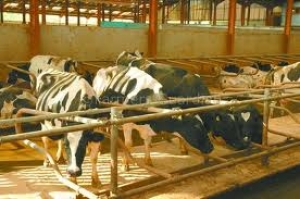Structure of reproductive system
Managing Endometritis In Dairy Cows

Infection results in a slower rate of recovery of the uterus following calving and delays the start of ovarian activity resulting in an increase in the time to first service of around 30 days even when the cow is treated.
Endometritis reduces the chance of successful insemination and increases the risk of infertility culling; it is therefore an important cause of reduced fertility in dairy herds. With Kingshay, independent dairy specialists, estimating the cost of delayed breeding at over £5 a day then a case of whites could take £150 profit in extra open days alone.
From time to time all herds experience an outbreak of whites and it is worth considering the factors that increase the chances of infection occurring so that these risks can be managed. Retained membranes, calving difficulties, abortions, the birth of dead calves and twins all increase the chances of a cow developing endometritis.
Nutrition is also important, cows that are too fit at calving or those that mobilise body fat in their dry period or get milk fever at calving are at increased risk and low intakes of vitamin E and selenium have also been linked to the problem. As with many dairy cow health and fertility issues therefore the transition period is a good place to start to deal with endometritis problems.
Stale cows should be dried off as near to condition score 2.5 as possible and then fed to maintain this during their dry period. Before calving the ration should contain all the elements of the milker’s diet, it should be freely available and very palatable, if not cows will mobilise their body reserves which increases the risk of many post calving disorders.
A drop in intake of 1 kg in the last week of pregnancy has been shown to make endometritis nearly three times more likely. Group changes are very disruptive to cows feeding patterns, it is better to try to move cows into a transition group once a week rather than on a daily basis if herd and pen sizes allow it.
Whether you are restricting dietary calcium or feeding a negative DCAD ration to dry cows make sure that milk fever is controlled and that cows don’t have to rely on routine calcium injections at calving to keep them on their feet. Once blood calcium levels have dropped uterine contractions will have been affected and fertility will have been reduced. Dry cow rations should contain at least 1500 iu of vitamin E daily.
Bull choice is obviously very important in limiting calving problems, checking the calving ease index when selecting sires for maiden heifers reduces the need to get the calving jack out and clean calving boxes and disinfected calving ropes will reduce the risk of introducing infection into the uterus. Twins can’t be avoided but abortions and stillbirths can be reduced by controlling infectious causes of infertility such as BVD virus and Leptospirosis, vaccination can be a useful tool.
If more than 10 per cent of the herd are getting whites cows with the main risk factors should be checked during your regular veterinary fertility visit. Pre-breeding examinations of cows that aborted or had calving problems or dead calves, twins, milk fever or retained fetal membranes will allow prompt treatment. If they aren’t checked whites can end up being found when the cow is presented later as not seen in heat and more time is lost.
Studies have shown that the reproductive tracts of over 80 per cent of cows are contaminated after calving but that the processes that clear this infection such as uterine contraction and the cow’s immune system are very efficient at removing it if the cow is well looked after and not stressed unduly. Attention to detail is the key to avoiding endometritis.























